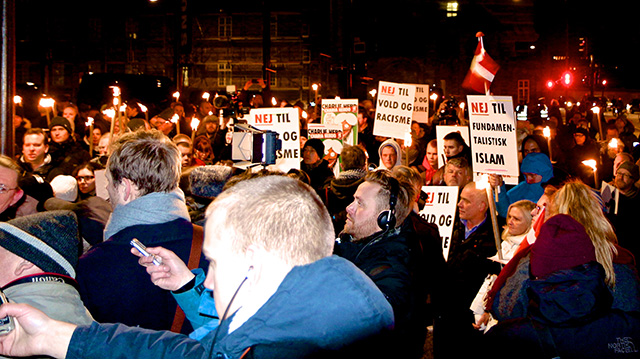
On January 19, 2015, supporters of the Pegida movement participated in their first Copenhagen rally, following earlier anti-Islam events in Dresden. In response, four times as many people showed up for an anti-Pegida rally to oppose their efforts.
On the evening of January 19, 2015, approximately 150 people gathered to support the Pegida movement’s first rally in Copenhagen. Conservative political activist and leader of the grassroots organization Pegidadk (“dk” is for Denmark), Nicolai Sennels drew inspiration from the growing anti-Islamic movement by the same name that arose in October 2014 in Dresden and attracted escalating crowds in response to the recent violent attacks on Charlie Hebdo staff in France. The acronym Pegida is derived from the German: Patriotische Europäer gegen die Islamisierung des Abendlandes; in English: Patriotic Europeans Against the Islamization of the West.
Nativism and a pervasive fear of “Islamization” are at the heart of the Pegida movement. Sennels (an unsuccessful Danish People’s Party candidate for election to the Danish Parliament in 2011, born in 1976) is a harsh critic of Islam in general and of Muslims’ immigration to Denmark and Europe, in particular. Countering accusations that “Islamophobia” is at the heart of his beliefs, Sennels instead advocates the term “Islamonausea” instead “to describe a feeling of nausea, disgust, displeasure, discomfort or aversion that arises by itself when encountering Islam or Islamic culture, or whatever or whoever represents it.”
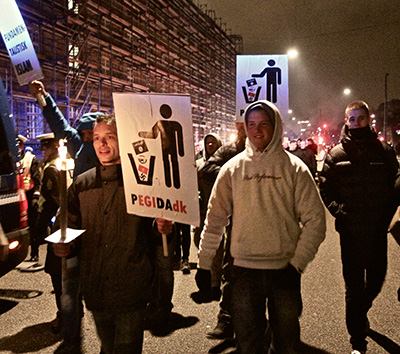 Nicolai Sennels (left, holding PEGIDAdk sign and a torch) led the PEGIDA march to the Little Mermaid statue, a symbol of Danish national identity. (Photo: Linda Pershing)
Nicolai Sennels (left, holding PEGIDAdk sign and a torch) led the PEGIDA march to the Little Mermaid statue, a symbol of Danish national identity. (Photo: Linda Pershing)
In a December 31, 2014, essay entitled “Why We Fight Islam,” he contends that “[t]he goal in Islam is world domination and a central part of every Muslim’s religious practice is to spread his [sic] faith with all possible means until it covers the Earth completely.” Sennels’ statements about Islam and Muslims include assertions about genetic inferiority: “A rough estimate shows that close to half of all Muslims in the world are inbred” (February 9, 2010); and “After 40 years of constantly growing problems [caused by] Muslim immigrants in Europe, it is now clear to everyone: integration of Muslims in Western societies cannot be done” (April 4, 2009, Fyens Stiftstidende; note: no longer available on their website but cited by several other sources).
While public pronouncements (including websites and posters at rallies) by Pegidadk members emphasize “no to violence and racism” and opposition to “fundamentalist Islam,” Sennels’ profound xenophobia regarding Muslims, as well as Denmark’s long (but not widely recognized) history of anti-immigrant traditions, betray disturbing connections to a history of racism and xenophobia in Danish cultural life. Pegidadk followers would do well to visit relevant exhibits currently on display at the City Museum of Copenhagen, including “Wanted-Unwanted,” “Becoming a Copenhagener” and “100% Copenhagen.” (Watch the Danish theater performance of “100% Copenhagen.”) They detail the long and often troubled history of immigration in Copenhagen. Museum visitors learn about the Danish tradition of nationalistic and often exclusionary policies regarding immigrants. Noting that 23 percent of the people currently living in Copenhagen are immigrants, the exhibits explore the experiences of Jews, Roma and immigrants from various parts of Europe, Asia, Africa, Turkey and the Middle East, who traveled to Copenhagen in an attempt to create new and better lives for themselves and their loved ones.
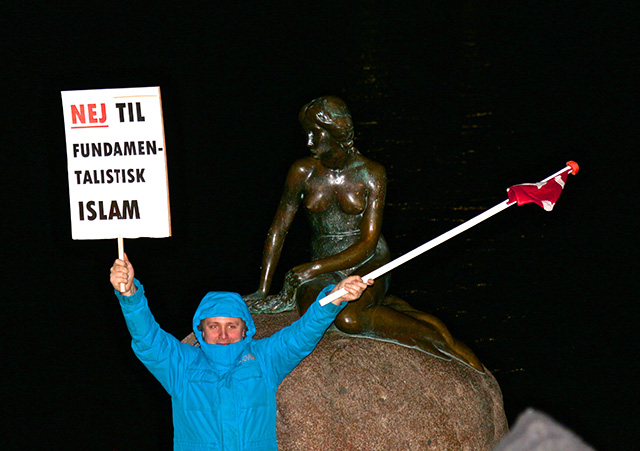 An enthusiastic PEGIDAdk supporter waves the Danish flag and a “No to fundamentalist Islam” sign in front of the Little Mermaid statue. (Photo: Linda Pershing)
An enthusiastic PEGIDAdk supporter waves the Danish flag and a “No to fundamentalist Islam” sign in front of the Little Mermaid statue. (Photo: Linda Pershing)
The museum documents a long history of the expulsion and exclusion of particular types of foreigners (different groups during various time periods), horrible living conditions, abysmal housing, a total lack of sanitation for immigrant workers, the effects of romantic nationalism on definitions of who “belonged” in Denmark, restrictions on access to jobs and public services, and officials and pundits decrying the “degradation” of Danish society by foreigners (especially those with darker skin and other religious traditions). Visitors learn, for example, that in 2010, 28.3 percent of the residents of Copenhagen’s Nørrebro district were immigrants, including large populations from Palestine, Lebanon and Iraq.
These lessons were lost on those who attended the first small and poorly organized Pegidadk rally. Despite considerable advanced publicity by Danish press – mainly drawing on reaction to the Charlie Hebdo-related attacks and corresponding rallies of 20,000 or more in Dresden in the weeks before – somewhere between 100 and 200 people participated (and were besieged by a dozen or so reporters and photographers). The crowd was primarily middle-aged or older; only one person of color was evident. A few ardent young women stood near the front of the group and waved their signs enthusiastically as Sennels spoke to the group. After a couple of short speeches, they marched – with a bevy of police officers and vehicles surrounding them – from the National Gallery of Art to the Little Mermaid statue on the harbor (a famous landmark to honor Danish fairy tale author H.C. Andersen).
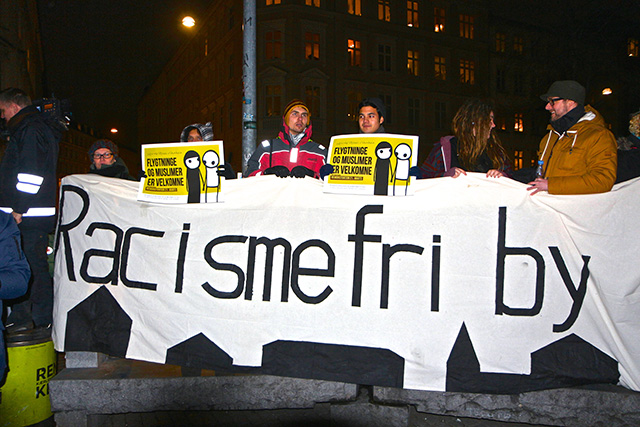 Activists at the Copenhagen anti-PEGIDA rally display signs reading “Racism Free City” and “Immigrants and Muslims Are Welcome.” (Photo: Linda Pershing)
Activists at the Copenhagen anti-PEGIDA rally display signs reading “Racism Free City” and “Immigrants and Muslims Are Welcome.” (Photo: Linda Pershing)
As they arrived at their destination, the group seemed a bit lost. A young man waving a Danish flag in one hand and pre-printed sign reading “Nej til fundamentalisk Islam” (“No to fundamentalist Islam”) posed in front of the Little Mermaid statue on the shoreline, while journalists and other participants recorded the moment on film. There were no speeches or rallying cries at their destination. A couple of counter-protesters on the sidelines chanted their own slogans and were quickly removed from the area by police. Some marchers returned to their starting point, while much of the group dissipated and went their separate ways.
Commenting that even the word “march” sounds too militant, Sennels described his vision for the first event as a “cozy” (hyggeligt) event, an “evening stroll” culminating in a sing-along of “a peace song” at the Little Mermaid statue. He neglected to mention that the song chosen by the group was a musical version of a 1936 poem entitled “Til ungdommen” (“For the Youth”), by Norwegian poet and writer Nordahl Grieg. Also known by the words of the first line, “Kringsatt av fiender” (“Surrounded [or Besieged] by Enemies”), the ballad has often been performed at memorial services for the victims of the July 2011 attacks in Norway. Ironically, those events – the setting off of a car bomb amid government buildings in Oslo, then the shooting and killing of 69 participants (many of them children) at a Workers’ Youth League summer camp in rural Norway – were committed by the type of “terrorist” seldom associated with that term. White, Norwegian citizen Anders Behring Breivik, a 32-year-old, right-wing militant, took it upon himself to massacre 77 people in the deadliest attack in that nation since World War II.
Immigration to Denmark and the heated debates that ensue when immigrants seem particularly “foreign” aren’t going away anytime soon. Although Pegidadk supporters were few in number at their first rally (another is planned for each successive Monday night), many other Danes seem to share their views and support their anti-Islam and anti-immigrant agenda. According to a recent poll conducted for the Jyllands-Posten newspaper, one in eight Danes wished there were a political party that would push even harder for immigration restrictions than the conservative Danish People’s Party (the party with which Sennels was aligned when he ran for a parliament seat).
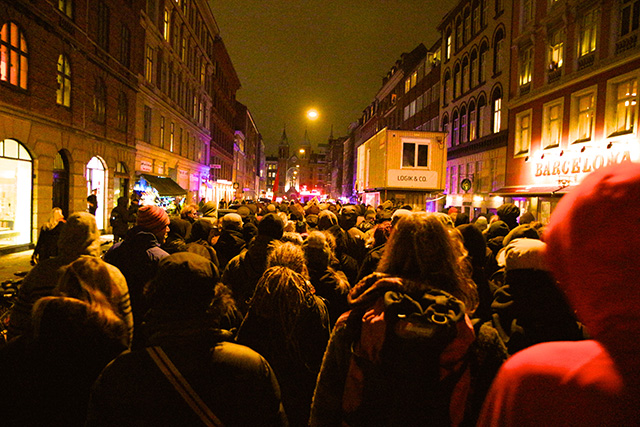 An estimated 400-to-500 people filled the streets of downtown Copenhagen in support of the anti-PEGIDA rally. (Photo: Linda Pershing)
An estimated 400-to-500 people filled the streets of downtown Copenhagen in support of the anti-PEGIDA rally. (Photo: Linda Pershing)
Recent Pegida rallies in Dresden have been widely criticized for their xenophobic and anti-immigrant rhetoric. In response, Sennels attempted to couch the fledgling Copenhagen campaign in fuzzy, non-racist, feel-good language. Stating that the Copenhagen movement “is not about a political stance or about being on the left or right,” he insists that the Danish Pegida movement “will be free of xenophobes and racists.” The Pegidadk Facebook page warned, “You should stay away if you are racist, a Nazi or look ‘militant,'” adding: “We want to avoid this getting high-jacked by some idiots or racists. That would be a pity, because there are a lot of completely normal Danish people – school teachers, my mother, etc. – who don’t necessarily vote for the right wing but who should be able to voice their aversion to this violent type of Islam.” At the root, the new Pegidadk movement is another development in a long history of nativist groups in Denmark, led by people who assert their dominance and sense of cultural superiority by way of nationalism and claims that foreign “others” pose a threat to the future and well-being of “real” Danes.
Limited by the censorship of signs and banners (none were handwritten or individualized; they had to be approved beforehand), as well as a subdued crowd that processed with little enthusiasm, the first Pegidadk rally lacked energy and vitality. Instead, the event also took on a more menacing tone: the Pegidadk Facebook page advertised that they would be carrying 100 burning torches during the nighttime march (it gets dark in Copenhagen at 4:30 pm). As Pegidadk supporters gathered for speeches and processed down the streets, the flaming torches conjured visions of an unruly and self-appointed throng from an earlier era, going after a beast or a monster.
Word about the Copenhagen Pegida rally quickly spread around social media and the internet. In response, the progressive Revolutionære Antifascister (Revolutionary Anti-Fascists), a Copenhagen-based organization that describes its mission as “fighting racism, fascism and xenophobia,” organized a counter-march. This was a larger gathering of 400 to 500 people – more teenagers and young adults, families with babies and children, and a more ethnically and racially diverse group – intended to counter the Pegida gathering. They were better organized and more exuberant, filling the streets with chants and music during their downtown Copenhagen procession. Young people carried large, handmade banners proclaiming their message: “Copenhagen Against Xenophobia, Stop Pegidadk,” “Refugees and Muslims Are Welcome” and “Racism Free City.” Local police kept the two groups separated by space and time: the counter-march was scheduled to end just as the Pegida rally started, and organizers were forced to move to a location further away from the Pegida group than they originally wanted. Both marches were carefully controlled by the police, including surveillance by a helicopter hovering in the skies throughout both rallies.
![In response to the PEGIDA rally, anti-PEGIDA activists display a “KBH [Copenhagen] against Xenophobia” banner at the counter march. (Photo: Linda Pershing)](https://truthout.org/app/uploads/legacy/images/Images_2015_01/2015_0129islam6.jpg) In response to the PEGIDA rally, anti-PEGIDA activists display a “KBH [Copenhagen] against Xenophobia” banner at the counter march. (Photo: Linda Pershing)
In response to the PEGIDA rally, anti-PEGIDA activists display a “KBH [Copenhagen] against Xenophobia” banner at the counter march. (Photo: Linda Pershing)
Revolutionære Antifascister activists assert that Pegidadk members are exploiting the attack on Charlie Hebdo in order to attract participation, noting: “[W]e will not accept that racist influences [should] exploit the tragedy in Paris – terror will not be stopped with more hatred.” Rather than responding with xenophobia and calls for the restriction and expulsion of Muslims in Denmark, they contend: “Our answer is more democracy, more openness and more diversity and tolerance. . . . We will be an alternative to the polarization of society between cultural, religious or ethnic groups. Such polarization creates only hatred and basis for new conflicts.” In response to the anti-Muslim rhetoric sweeping Western Europe, they suggest that recognizing and working to change systems of inequality and injustice are at the heart of the struggle: “We must not fight Muslims and immigrants, but the poverty, inequality and racism which are the causes of the conflicts and hatred.”
Pegidadk organizers state that they are planning marches every Monday. If so, the Revolutionary Antifascists and others in Copenhagen who oppose the anti-Muslim stance of Pegidadk will likely take to the streets in response. According to recent press reports, more than 11 percent of the population in Denmark is comprised of immigrants, and the number of non-Western immigrants who call Denmark home has increased more than fivefold since 1984. Add to this a growing awareness among the general public that economic inequality continues to rise between immigrants and Danes, and that Denmark – often portrayed as a paradise of equality where there is no major gap between the rich and poor – is becoming increasingly stratified by income. Currently, the richest 1 percent of Denmark’s population owns 43 percent of the country’s total wealth. This growing economic inequality is likely to fuel future discussions about immigration and anti-Islam movements in Denmark, and encourage those who support – and those who oppose – anti-Muslim xenophobia to take to the streets.
Join us in defending the truth before it’s too late
The future of independent journalism is uncertain, and the consequences of losing it are too grave to ignore. To ensure Truthout remains safe, strong, and free, we need to raise $24,000 by the end of today. Every dollar raised goes directly toward the costs of producing news you can trust.
Please give what you can — because by supporting us with a tax-deductible donation, you’re not just preserving a source of news, you’re helping to safeguard what’s left of our democracy.